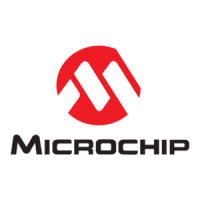Note: It is a common belief that because a component vendor says their IC can withstand ±15Kv that it already
provides adequate protection on the I/O, but that is not the only requirement for external interface components and
signals. Usually the ±15Kv rating is for the IEC 61000-4-2 air discharge specification. This is fine for non-external
interface signals, but does not cover the IEC 61000-4-2 ESD contact discharge with an ±8Kv @ 30 amp peak
current discharge requirement for equipment enclosure, external facing signals interfaces, ports, connectors, and
cable hardware.
There is comprehensive information available on ESD, EMI, or EFT on Microchip web site that can be found in the
document: AN2587 - EMI, EMC, EFT
, and ESD Circuit Design Consideration for 32-bit Microcontrollers, or on any of
the 32-bit product web pages under the tab Documentation > Application Notes.
Return to Checklist
11.6 USB
Important: All PIC32MX/PIC32MM and PIC32MK family of devices do not support Low-Speed USB
mode (refer to the errata document). Use Full-Speed mode instead.
Problem: 34: Why does a USB data transfer take longer than expected?
•
When data packets are dropped due to CRC errors caused by timing or signal integrity issues the USB protocol
allows continuous retries of the packets in all but Isochronous data transfers. This leads to long transfer times
as the same data packets are retransmitted over and over again until the CRCs match, see Cautions in the next
problem.
Problem: 35: Why will the USB DEVICE not enumerate?
Most USB issues are similar and come back to signal integrity and timing accuracy issues discussed in more detail
below.
• On SAM products and some PIC32C products:
The output drivers for the DP/DM USB line interface must be fine-tuned with calibration values
from production tests. The calibration values must be loaded by the user from the NVM Software
Calibration Area into the USB Pad Calibration (P
ADCAL) register by the software, before enabling the
USB, to achieve the specified accuracy.
For USB DEVICE only mode using the SOF clock recovery for the USB 48 MHz clock, the user must
first Load the DFLL
VAL.COARSE register prior to enabling the USB DEVICE from the “DFLL48M
COARSE CAL” NVM Software Calibration Area Mapping (Refer to the Data Sheet, if there is no
DFLL48M COARSE entry in the NVM Software Calibration Area Mapping there is a good chance
that it is handled by the hardware). For the SAMD21/D11/L21/L22 product families, or any that use
DFLL48M as the default startup oscillator, the user must load the calibration value manually by
software.
Problem 36: USB connection has been lost.
•
When USB transmission errors occur depending on the frequency of their incidence, the USB system software
determines if and when a timeout occurs or how many retry attempts are allowed. When either of those
thresholds are met the USB connection will be terminated.
• As per USB 2.0, any USB device can be classified as either low power (5V @ 100 mA) or high power (5 V
@ 500 mA). Once connected, a USB device is allowed to draw only100 mA current initially while enumerating
and negotiating its power budget with the host. Based on the enumeration, the host will either raise the power
delivery to 500 mA or continue at 100 mA. If the downstream device draws more power than either the Host
Serial Data Corruption Errors
© 2022 Microchip T
echnology Inc.
and its subsidiaries
Manual
DS70005439B-page 43

